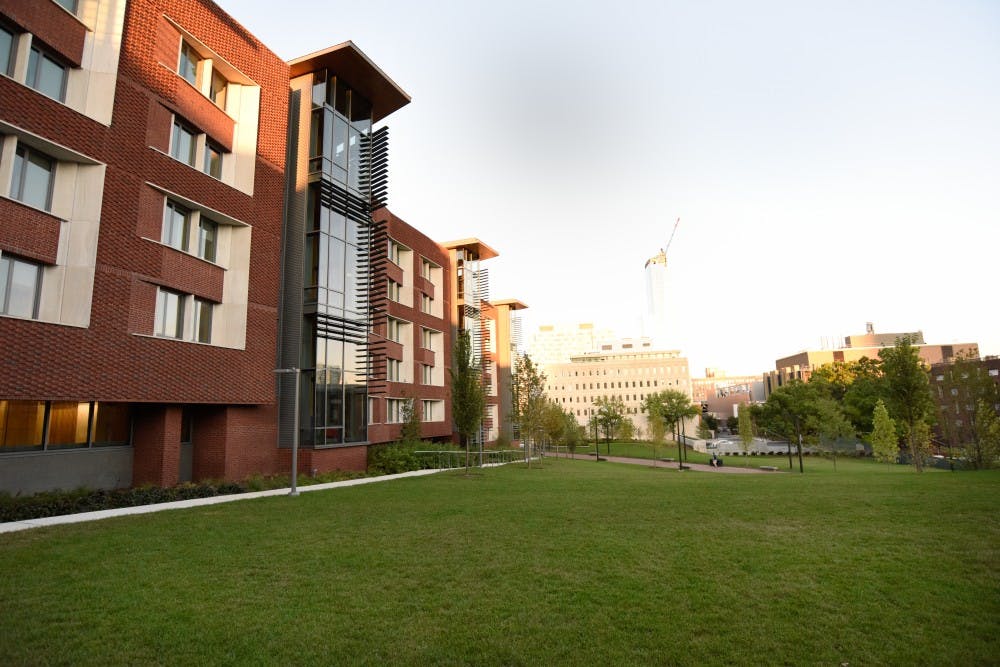“We are sustainable,” the homepage of Penn’s newly constructed New College House dorm reads.
Yet Penn only ranks No. 37 for sustainability out of U.S. News’ Top 100 Colleges list, according to a report released by SaveOnEnergy earlier this month.
The ranking is based on a composite score that evaluates the walkability, green jobs, farmers’ markets and parks in the area, and reviews by the Department of Energy and The Princeton Review.
The ranking comes out 15 days before Penn’s annual “Power Down” challenge, which was unsuccessful in 2015 — the report found that over half of the participating college houses saw an increase in electricity usage. In 2016, the event was changed to stop being a competition between the college houses, and Penn saw a 5.8 percent weather-normalized energy reduction.
“I think [the administration] has the right ideas, it’s just executing and implementing their intentions,” Co-Internal Chair of Penn Vegan Society and College sophomore Farah Contractor said. “Recycling is actually pretty confusing and hard the way Penn does it. A lot of the recycling bins are not even big enough to put in your salad containers which discourages students from recycling.”
However, sustainability has always had a presence at Penn. The Philadelphia region’s first Earth Day traces its roots back to the University in 1970. Penn President Amy Gutmann signed the American College and University Climate Commitment in 2007, which required the completion of an inventory of the school’s greenhouse gas emissions, the purchase of at least 15 percent of electricity from renewable sources, a commitment that new construction be built to the U.S. Green Building Council LEED Silver standards and increased access to public transportation. In 2014, Penn launched the Climate Action Plan 2.0, which involved investing hundreds of millions of dollars in projects that spanned from remodeling the top 20 percent of campus buildings that have the highest energy use to increasing the number of zero-waste events on campus each year.
“[Sustainability] has been a priority for the administration, even though it may not necessarily seem like it,” Eco-Rep Coordinator and College junior Jisoo Kim said. This past year, Green Campus Partnership revamped the student Eco-Rep program to become a more coordinated paid student internship.
Interestingly, on the same day the SaveOnEnergy report was released, the Environmental Protection Agency’s annual Green Power Partnership ranked Penn as the university with the third best annual green power usage — a far cry from 37th.
Environmental Sustainability Director Dan Garofalo, in an emailed statement to The Daily Pennsylvanian, noted that rankings done by “outside organizations” use “a variety of methodologies and data” while Penn is guided by the specific criteria put forth by the Climate Action Plan 2.0.
“I’m very grateful that we have the Penn sustainability office,” co-chair of the Student Sustainability Association at Penn and College junior Johanna Matt said. She said she spoke not as a representative of SSAP, but as an individual. She noted she believes that the University does more on the “infrastructure end” and ultimately “in some ways [the administration] is committed to being green, but in other ways they still don’t really consider it a priority.”
As for New College House, the University’s LEED Silver Certified building that claims sustainability in bold on their home page, Matt cites this building as a place where sustainability may not be as much of a priority as the University claims.
According to 2016 College graduate Elena Crouch, who was involved in focus groups during the construction of the dorm, designs did not leave enough room in the kitchen to put in a dishwasher, which is why all the plates and bowls are single-use.
“I was at a focus group before they built the dining hall,” Crouch said. “They just didn’t build enough space for a dishwasher ... we were all really upset ... but it couldn’t be stopped. They already had this plan.”
“[The Sustainability Office isn’t] happy about it for sure,” Kim said. “They were trying their best as soon as they found out about it, but I think it was already too late.”
Director of Business Services and Hospitality Services of Penn Dining Pam Lampitt clarified that the building ended up installing a low volume, single-well dish machine.
“We have something called a bio bin [where the used plates are put],” Lampitt said. “The product that comes out of the bio bin actually goes to a farm to be used for compost ... we’re being as sustainable as we can be given our situation.”
She added that a survey by Bon Appétit Management Company found that all products used by Penn Dining are recyclable except for five: chopsticks, napkins, straws, coffee stirrers and condiment packages. She said that signs at Penn Dining locations warn students to avoid using those products if they want to maintain sustainable practices.
As Penn continues to expand programs such as the Eco-Reps and build LEED Certified buildings, many remain optimistic about the future of sustainability at Penn.
“I see a lot of hope,” Matt said. “A lot of people are kind of coming together and working in their own ways to make a better place, and it’s really beautiful.”









